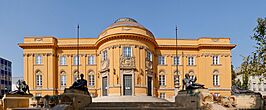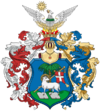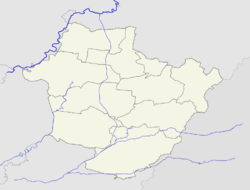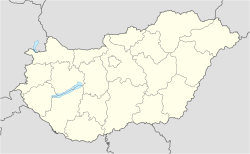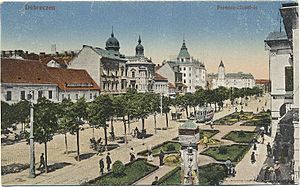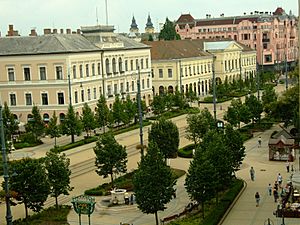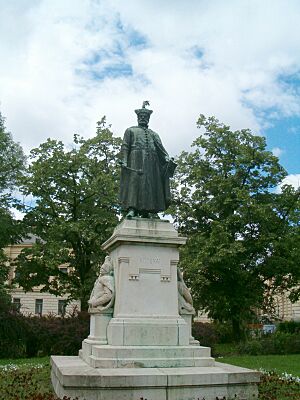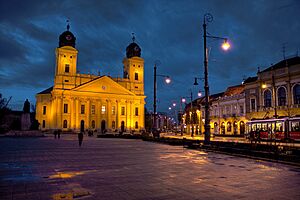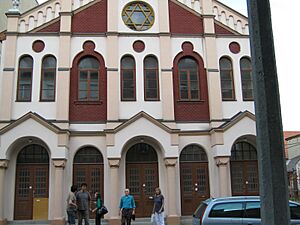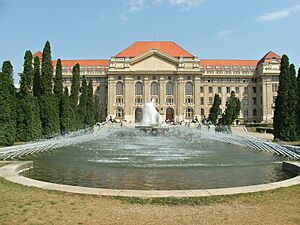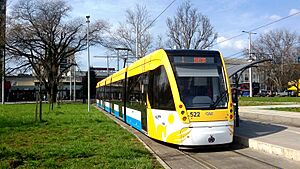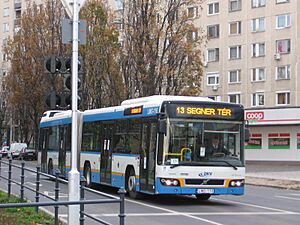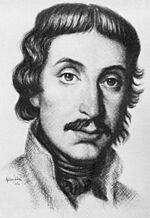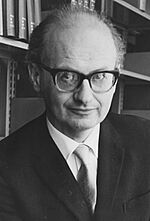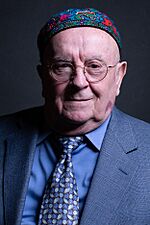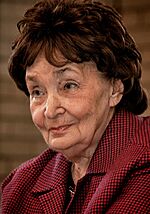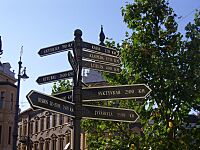Debrecen facts for kids
Quick facts for kids
Debrecen
|
|||
|---|---|---|---|
|
City with county rights
|
|||
| Debrecen Megyei Jogú Város | |||
|
Descending, from top: Déri Museum, University of Debrecen, and Protestant Great Church
|
|||
|
|||
| Nicknames:
The Calvinist Rome, Cívis City
|
|||
| Country | |||
| Region | Northern Great Plain | ||
| County | Hajdú-Bihar | ||
| District | Debrecen | ||
| Established | 9th century AD | ||
| City status | 1218 | ||
| Area | |||
| • City with county rights | 461.25 km2 (178.09 sq mi) | ||
| Area rank | 3rd in Hungary | ||
| Elevation | 121 m (396.98 ft) | ||
| Highest elevation | 151 m (495 ft) | ||
| Population
(2019)
|
|||
| • City with county rights | 202,402 |
||
| • Rank | 2nd in Hungary | ||
| • Density | 442.09/km2 (1,145.0/sq mi) | ||
| • Urban | 328,642 (2nd) | ||
| Demonym(s) | debreceni, cívis | ||
| Population by ethnicity | |||
| • Hungarians | 84.8% | ||
| • Romani | 0.6% | ||
| • Germans | 0.6% | ||
| • Romanians | 0.3% | ||
| • Other | 2.0% | ||
| Population by religion | |||
| • Calvinist | 24.8% | ||
| • Roman Catholic | 11.1% | ||
| • Greek Catholic | 5.1% | ||
| • Lutheran | 0.4% | ||
| • Jews | 0.1% | ||
| • Other | 2.3% | ||
| • Non-religious | 27.8% | ||
| • Unknown | 28.4% | ||
| Time zone | UTC1 (CET) | ||
| • Summer (DST) | UTC+2 (CEST) | ||
| Postal code |
4000 to 4032, 4063
|
||
| Area code | (+36) 52 | ||
| Motorways | M35 Motorway | ||
| NUTS 3 code | HU321 | ||
| Distance from Budapest | 231 km (144 mi) West | ||
| International airports | Debrecen (DEB) | ||
| MPs |
List
|
||
Debrecen is Hungary's second-largest city, right after Budapest. It's a major hub in the Northern Great Plain region and the main city of Hajdú-Bihar County. Debrecen was once the biggest city in Hungary during the 1700s and is still a very important cultural center for Hungarian people.
It even served as the capital of Hungary twice! First, during the revolution in 1848–1849, and again at the end of World War II in 1944–1945. The famous University of Debrecen is also located here.
Contents
What's in a Name?
The city's name, first written as Debrezun in 1235, has a few possible origins. One idea is that it comes from a Turkic word, debresin, meaning 'live' or 'move'. Another theory suggests it's from a Slavic word meaning 'well-esteemed' or 'good land'. A third idea links it to a Proto-Slavic word for 'gorge'.
A Look Back in Time
Debrecen was founded after the Hungarians settled in the area. It grew quickly after the 1200s, especially when people from smaller, nearby villages moved there.
In 1361, King Louis I of Hungary gave the people of Debrecen the right to choose their own judge and council. This was a big step, giving the town more control over itself. By the early 1500s, Debrecen was a busy market town.
During the time of the Ottoman Empire, Debrecen was often in a tricky spot because it was near the border and didn't have strong walls. Its leaders had to be very clever to keep the city safe. Sometimes, the city was protected by the Ottomans, and other times by European rulers.
Debrecen was one of the first cities to embrace the Protestant Reformation. Because of this, it became known as "the Calvinist Rome" or "the Geneva of Hungary." Most of the people living there at this time were Hungarian Calvinists.
In 1693, Debrecen was given "free royal town" status by Leopold I, Holy Roman Emperor. This meant it had special rights and freedoms. The Roman Catholic Church also returned to the city in 1715. Debrecen grew into an important center for culture, trade, and farming. Many famous scholars and poets studied at its Protestant College.
In 1849, Debrecen became the capital of Hungary for a short time. This happened when the Hungarian revolutionary government moved there from Pest-Buda (now Budapest). In April 1849, Hungary declared its independence from the Habsburg rulers in the Great Church. The last battle of the war for independence also took place near Debrecen.
After the war, Debrecen slowly started to thrive again. A railway line connecting it to Budapest was finished in 1857, making Debrecen an important railway hub. New schools, hospitals, churches, and factories were built. The city began to look more modern with taller buildings, parks, and villas. In 1884, Debrecen was the first Hungarian city to have a steam tramway.
After World War I, Hungary lost some of its eastern lands to Romania, which meant Debrecen was once again close to the country's new border. The city was even occupied by the Romanian army for a short time in 1919. Tourism helped the city recover. Many new buildings, like an indoor swimming pool and Hungary's first stadium, were built in the central park, the Nagyerdő ("Big Forest"). The university building was also completed.
During World War II, Debrecen was heavily damaged, with many buildings destroyed. A big battle, the Battle of Debrecen, happened near the city in October 1944. Soviet troops captured Debrecen on October 20. After 1944, the city began to rebuild and was briefly the capital of Hungary again. However, the new Communist government changed many things, taking over private properties and institutions. Half of Debrecen's area was given to nearby towns, and the city lost its rights over the famous Hortobágy area.
People of Debrecen
| Historical population | ||
|---|---|---|
| Year | Pop. | ±% |
| 1870 | 45,132 | — |
| 1880 | 50,320 | +11.5% |
| 1890 | 56,246 | +11.8% |
| 1900 | 73,878 | +31.3% |
| 1910 | 90,764 | +22.9% |
| 1920 | 101,543 | +11.9% |
| 1930 | 116,013 | +14.3% |
| 1941 | 124,148 | +7.0% |
| 1949 | 115,399 | −7.0% |
| 1960 | 134,930 | +16.9% |
| 1970 | 167,860 | +24.4% |
| 1980 | 198,195 | +18.1% |
| 1990 | 212,235 | +7.1% |
| 2001 | 211,034 | −0.6% |
| 2011 | 211,320 | +0.1% |
| 2022 | 199,000 | −5.8% |
| Census data for the present territory of Debrecen. | ||
Languages Spoken
In 2011, almost everyone in Debrecen (99.3%) spoke Hungarian. Many people also spoke English (23.6%), German (10.6%), and Russian (2.6%).
Different Backgrounds
Most people in Debrecen are Hungarian (84%). There are also smaller groups of Romani, Germans, and Romanians. Many people did not state their ethnicity in the census.
| Largest groups of foreign residents | |
| Nationality | Population (2011) |
|---|---|
| 1,303 | |
| 739 | |
| 305 | |
| 262 | |
| 166 | |
| 126 | |
| 98 | |
| 98 | |
Religion in Debrecen
Religion in Debrecen (2022) Calvinism (22.4%) Roman Catholicism (9%) Greek Catholicism (5.4%) Evangelical Christianity (0.4%) Other (2.8%) Undeclared (39%) Irreligion (21%)
Many people in Debrecen are Hungarian Reformed (Calvinist), making up about a quarter of the population. Other religions include Latin Catholic and Greek Catholic. A significant number of people are not religious or did not state their religion.
The Reformed Church
Since the 1500s, the Protestant Reformation, especially the teachings of John Calvin, became very important in Debrecen. The city's government even became Calvinist. This is why Debrecen is often called the "Calvinist Rome" or "Geneva of Hungary."
The city is home to the Reformed Theological University of Debrecen, which was founded in 1538. It was the only Calvinist theological school allowed to operate in Hungary during the communist era. The Hungarian Reformed Church has about 20 groups in Debrecen, including the famous Reformed Great Church of Debrecen, which can hold around 5,000 people.
The Jewish Community
Jewish people were first allowed to live in Debrecen in 1814. Over time, their community grew, and by 1919, they made up 10% of the city's population. They owned many businesses and properties.
However, during World War II, the Jewish community faced terrible challenges. Many Jewish businesses were forced to close, and people were made to wear a yellow star. The community was forced into a special area called a ghetto. Later, many were taken from the city.
After the war, about 4,000 Jewish people from Debrecen and nearby areas survived. They rebuilt their community, which became the largest in the region. While many later moved to Israel or other Western countries, a Jewish community still exists in Debrecen today, with two synagogues.
Weather in Debrecen
Debrecen has a humid continental climate, which means it has warm summers and cold winters. The average temperature for the year is about 11.0°C (51.8°F). July is usually the hottest month, with an average of 21.9°C (71.4°F), and January is the coldest, averaging -0.8°C (30.6°F).
The city gets about 542.7 mm (21.4 inches) of rain each year. July is the wettest month, and January is the driest.
| Climate data for Debrecen, 1991−2020 normals, extremes 1901-2022 | |||||||||||||
|---|---|---|---|---|---|---|---|---|---|---|---|---|---|
| Month | Jan | Feb | Mar | Apr | May | Jun | Jul | Aug | Sep | Oct | Nov | Dec | Year |
| Record high °C (°F) | 15.4 (59.7) |
19.1 (66.4) |
26.4 (79.5) |
33.6 (92.5) |
33.4 (92.1) |
37.4 (99.3) |
38.7 (101.7) |
39.2 (102.6) |
36.4 (97.5) |
29.5 (85.1) |
25.5 (77.9) |
17.4 (63.3) |
39.2 (102.6) |
| Mean daily maximum °C (°F) | 2.3 (36.1) |
5.0 (41.0) |
10.9 (51.6) |
17.7 (63.9) |
22.5 (72.5) |
26.0 (78.8) |
27.8 (82.0) |
28.1 (82.6) |
22.6 (72.7) |
16.6 (61.9) |
9.8 (49.6) |
3.2 (37.8) |
16.0 (60.8) |
| Daily mean °C (°F) | −0.8 (30.6) |
0.9 (33.6) |
5.8 (42.4) |
11.9 (53.4) |
16.8 (62.2) |
20.3 (68.5) |
21.9 (71.4) |
21.8 (71.2) |
16.5 (61.7) |
11.0 (51.8) |
5.5 (41.9) |
0.4 (32.7) |
11.0 (51.8) |
| Mean daily minimum °C (°F) | −3.6 (25.5) |
−2.7 (27.1) |
1.2 (34.2) |
6.1 (43.0) |
10.8 (51.4) |
14.6 (58.3) |
16.0 (60.8) |
15.7 (60.3) |
11.2 (52.2) |
6.2 (43.2) |
2.1 (35.8) |
−2.2 (28.0) |
6.3 (43.3) |
| Record low °C (°F) | −30.2 (−22.4) |
−26.0 (−14.8) |
−17.8 (0.0) |
−7.1 (19.2) |
−3.0 (26.6) |
−0.4 (31.3) |
5.2 (41.4) |
2.7 (36.9) |
−2.9 (26.8) |
−14.9 (5.2) |
−19.0 (−2.2) |
−28.0 (−18.4) |
−30.2 (−22.4) |
| Average precipitation mm (inches) | 24.3 (0.96) |
32.2 (1.27) |
30.0 (1.18) |
45.1 (1.78) |
59.3 (2.33) |
66.8 (2.63) |
67.7 (2.67) |
46.4 (1.83) |
47.3 (1.86) |
41.1 (1.62) |
40.5 (1.59) |
42.0 (1.65) |
542.7 (21.37) |
| Average precipitation days (≥ 1.0 mm) | 6.1 | 6.6 | 6.1 | 6.8 | 8.4 | 8.2 | 7.6 | 6.0 | 6.6 | 6.2 | 6.9 | 7.1 | 82.6 |
| Average relative humidity (%) | 84.4 | 78.8 | 68.6 | 62.2 | 65.1 | 66.5 | 65.9 | 64.2 | 69.7 | 77.0 | 83.7 | 85.5 | 72.6 |
| Mean monthly sunshine hours | 57.6 | 85.0 | 146.8 | 190.3 | 251.4 | 266.4 | 295.3 | 274.3 | 201.7 | 155.1 | 72.2 | 47.0 | 2,043.1 |
| Source 1: HMS | |||||||||||||
| Source 2: Ogimet(June record high), NOAA | |||||||||||||
Culture and Education
Debrecen has been a major center for learning and culture since the 1500s, thanks to the Reformation and the famous Reformed College. This college grew into the University of Debrecen in 1912. It's now the largest university in Hungary, with over 100 departments and a big research facility. The university is also known for its cactus research lab in the botanic gardens.
Many famous writers and poets have connections to Debrecen. Mihály Csokonai Vitéz, one of Hungary's best-known poets, was born and lived here. The city's theatre, built in 1865, is named after him.
Debrecen is also home to Tankcsapda, a very popular Hungarian rock band. There's even a rock school in the city for young musicians. The city has local newspapers, TV channels, and radio stations.
Every August, Debrecen hosts a wonderful flower festival called the Flower Carnival of Debrecen. The city is also part of the European Grand Prix for Choral Singing and hosts the Béla Bartók International Choir Competition.
Economy and Business
Debrecen's economy is boosted by farming, healthcare, and education. It's a major shopping center for Eastern Hungary, with Forum Debrecen being the largest mall in the region. Many international companies, like National Instruments, BT, Continental, BMW, and Teva Pharmaceutical Industries Ltd., have chosen Debrecen as a base.
Where is Debrecen?
Debrecen is located on the Great Hungarian Plain, about 220 km (137 mi) east of Budapest. The beautiful Hortobágy National Park is also nearby.
Getting Around
It's now easy to reach Debrecen from Budapest thanks to the M35 motorway. The Debrecen International Airport is Hungary's second-largest airport and has been updated to handle more international flights. You can fly to cities like Brussels, London, and Paris from here.
Debrecen has many railway stations, with the main station being the most important. The city's location near Ukraine, Slovakia, and Romania helps it grow as a trade and transport hub.
Within the city, you can travel by buses, trolleybuses, and trams. There are two tram lines, five trolleybus lines, and 60 bus lines, all run by the DKV company. Buses also connect Debrecen to nearby towns and villages.
Sports in Debrecen
Debrecen is famous for its football (soccer) club, Debreceni VSC. They have won the top Hungarian league seven times! They've also played in big European competitions like the 2009-10 UEFA Champions League group stage and the 2010-11 UEFA Europa League group stage. Their new stadium, opened in 2014, also hosts games for the Hungary national football team.
The city has hosted several international sports events, including:
- The 2001 World Youth Championships in Athletics in 2001.
- The 2006 IAAF World Road Running Championships in 2006.
- The European Short Course Swimming Championships 2007 in 2007.
- The World Artistic Gymnastics Championships in 2002.
- The 19th FAI World Hot Air Balloon Championship in 2010.
- The 2012 European Aquatics Championships in 2012.
The Debrecen Speedway team races at the Perényi Pál Salakmotor Stadion.
Football Clubs
- Debreceni VSC (plays in the top league)
- Bocskai FC (no longer active)
- Dózsa MaDISz TE (no longer active)
- Debreceni EAC
Places to See
- City Downtown
- Reformed Great Church (Nagytemplom)
- City Park (Nagyerdő) and spa
- Déri Museum (has art, ancient Egyptian items, and weapons)
- Flower Carnival of Debrecen (held every year on August 20)
- Nagyerdei Stadion (the home football stadium for Debreceni VSC)
- Csokonai theatre
Notable People from Debrecen
Born in Debrecen
- Mihály Csokonai Vitéz (1773–1805), a famous poet
- Zsolt Baumgartner (born 1981), Hungary's first Formula One driver
- Boglárka Kapás (born 1993), a swimmer who won a World Championship and Olympic medal
- Imre Lakatos (1922–1974), a philosopher of science
- Magda Szabó (1917–2007), a well-known writer
- Vivien Keszthelyi (born 2000), a racing driver
Lived in Debrecen
- Endre Ady (1877–1919), a poet
- Sándor Petőfi (1823–1849), a poet
- Éva Risztov (born 1985), an Olympic champion swimmer
Sister Cities
Debrecen has many sister cities around the world, which helps build friendships and cultural exchange. Some of them include:
 Košice, Slovak Republic
Košice, Slovak Republic Brno, Czech Republic
Brno, Czech Republic Cattolica, Italy
Cattolica, Italy Jyväskylä, Finland
Jyväskylä, Finland Klaipėda, Lithuania
Klaipėda, Lithuania Limerick County, Ireland
Limerick County, Ireland Lublin, Poland
Lublin, Poland New Brunswick, United States
New Brunswick, United States Oradea, Romania
Oradea, Romania Paderborn, Germany
Paderborn, Germany Patras, Greece
Patras, Greece Rishon LeZion, Israel
Rishon LeZion, Israel Saint Petersburg, Russia
Saint Petersburg, Russia Setúbal, Portugal
Setúbal, Portugal Shumen, Bulgaria
Shumen, Bulgaria Syktyvkar, Russia
Syktyvkar, Russia Taitung City, Taiwan
Taitung City, Taiwan Toluca, Mexico
Toluca, Mexico Tongliao, China
Tongliao, China
Images for kids
See also
 In Spanish: Debrecen para niños
In Spanish: Debrecen para niños


